
|   |

|   |
 e-mail: sunilkothari1933@gmail.com Golden Jubilee of National Centre for the Performing Arts Photos courtesy: NCPA December 16, 2019 On 28th November all roads led to Nariman Point to National Centre for the Performing Arts in Mumbai. The occasion was the grand celebrations of 50 years of the Centre. Associated with NCPA for more than 40 years, it was for me a sentimental journey. The large crowd of aficionados, dancers, musicians, painters, drama directors, actors, music lovers, in particular from the Parsi community, moved to Jamshed Bhabha Theatre, the large auditorium named after Jamshed Bhabha, the patron and Trustee of NCPA. Almost modeled on the Garnier, Paris Opera House, with two side marble staircases and imposing foyer, it was bustling with who is who of Mumbai's art loving public. 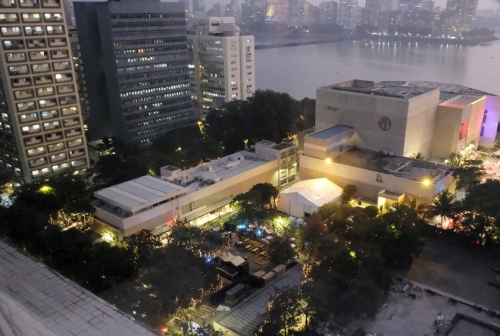 View of NCPA The inaugural event was a Western music concert by Symphony Orchestra of India (SOI); the proud dream of late Jamshed Bhabha and his successor, the present Chairman and trustee Mr. Santook. The bright auditorium was filled to the brim, and a large stage on which was seated more than 1000 performers, choirs from around India and orchestra led by conductor Zain Dalal, violin by Marat Bisengaliev, dancers from the Kazak State Academic Theatre of Opera and Ballet named after Abay. It was a grand affair. The excerpts of the classical Western music of Tchaikovsky, Mozart, and several great musicians along with excerpts of ballets, including a sequence of solo Swan transported the audience to one of the excellent opera houses of the west. The ballet dancers with their impeccable training, the male dancers lifting the ballerinas on shoulder up in the air, and ballerina's incredible breathtaking pirouettes on one leg were extremely impressive. It was a sumptuous affair of classical Western music and ballet, a well curated opening of the festival.  (Photo: Sunil Kothari) In the foyer were displayed a galaxy of artists' photographs who have performed at NCPA. Name them and they are there - M.S. Subbulakshmi, Pandit Ravi Shankar, Bhimsen Joshi, Vilayat Khan, Pandit Mallikarjun Mansoor, Pandit Birju Maharaj, Zakir Hussain, Balasaraswati, Mrinalini Sarabhai, P. L. Deshpande, and of course, the visionaries JRD Tata and Jamshed Bhabha who gifted the National Centre for the Performing Arts to the nation. It was like going down memory lane watching these photographs as I had attended most of the performances by these legendary musicians and dancers. As luck would have it, I saw a rare photo taken 30 years ago with Jamshed Bhabha in which Kathak exponent Kumudini Lakhia is flanked between Jamshed Bhabha and me! 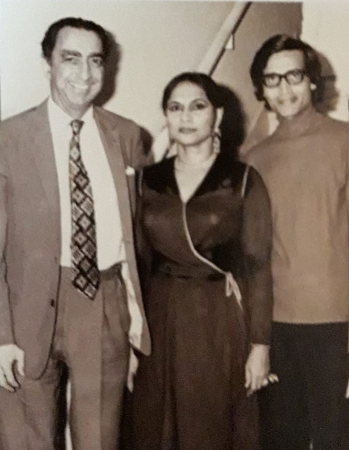 Jamshed Bhabha, Kumudini Lakhia & Sunil Kothari The NCPA monthly magazine 'On Stage' of November and December are collector's items. And to add to these two magazines the programme book NCPA ADD ART FESTIVAL offers the audience an amazing variety of entertainment, with few free admission and few ticketed events. The entire complex of NCPA had turned into a venue with open gardens and plaza where eateries were provided that catered to multi cuisine taste of the Mumbaikars. Though I have been a frequent visitor to NCPA, I had not seen such designing of the venue that looked like a Mayajaal! NCPA Add Art Festival 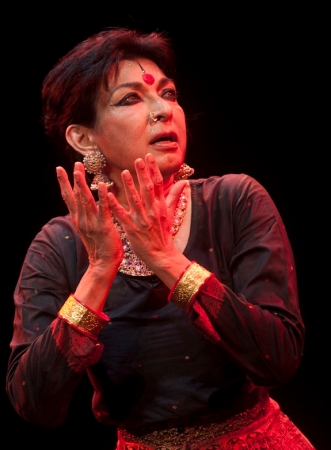 Mallika Sarabhai 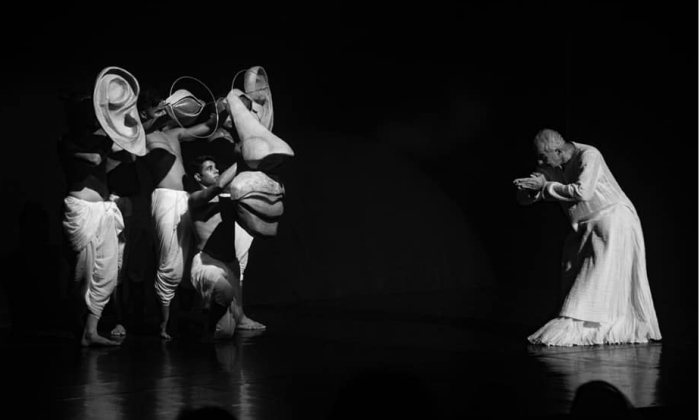 Astad Deboo & group (Photo: Neelesh Kale) Astad Deboo astounded the audience in his choreography with his troupe of Salam Balak Trust dancers, in the end bringing the wooden parts of nose, ears, eyes, mouth and spectacles of Gandhiji. The dancers well versed in Kalaripayattu, did justice to Astad's choreography. Their headstands, leaps in the air, groupings, walking with wooden sticks, suggesting the revolt against the tax imposed by the Govt on salt, Astad's pirouettes, and salutations to Gandhi were performed with sophistication and easy communication. Conceptualized imaginatively for relationships based on four principles of Respect, Understanding, Acceptance and Appreciation, Astad emphasized the humanity which Gandhiji advocated. The toughest battle Astad reiterated was to stand alone battered by the winds of indifference when courage is required. Astad said that 50 years ago he had performed at Little Theatre in NCPA and this was his homage for its Golden Jubilee. The other events after two dance recitals were standup comedy, screening of a Hindi film, live screening of Mid Summer Night's Dream from London, Jazz concert and one more standup comedy. The curating of all these events was quite mind blowing, but it must be said to the credit of all departments concerned, the planning was meticulous catering to various tastes, genres of performances of a vast and diverse audience. A series of Dance Appreciation 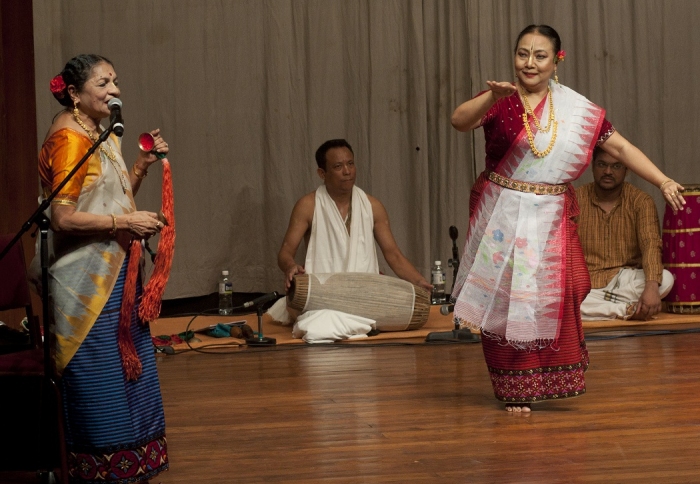 Darshana Jhaveri  Sandhya Purecha On 30th November a series of Dance Appreciation for six forms including Manipuri, along with the drummers Brojen for Manipuri and young son of Jayashree for mridangam, Sattriya dances with screening of film 'Mists of Majuli Island' giving glimpses into the life of monks in Sattra with my talk on Sattriya dances, Mohiniattam by Mandakini Trivedi and her disciple, Kathakali by Kalamandalam Vikraman and artists of Dr Kanak Rele's Nalanda Nritya Kala Mahavidyalaya, Kuchipudi by Singapore based Shanta Rati and Odissi by Jhelum Paranjape, Daksha Mashruwala and Debi Basu, was organized from 10am till 8pm with enough intervals when in the foyer dancers and rasikas sat on the floor and continued discussing the various aspects of the dance forms. The previous evening, Dance Appreciation series included Kathak by Uma Dogra and Bharatanatyam by Sandhya Purecha. Well curated by Swapnokalpa, Director of Dance Division of NCPA, it was a successful series which gave audience a sense of living traditions and its richness. Each presenter presented the form in its multiple varieties which the full house audience at the Little Theatre relished. I would like to mention in particular the comparative aspect of Manipuri talas with South Indian tala systems by Darshana Jhaveri and Bharatanrityam presentation by Jayashree Rajagopalan. 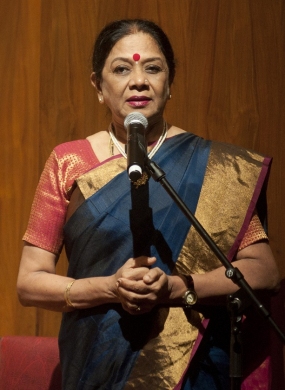 Jayashree Rajagopalan 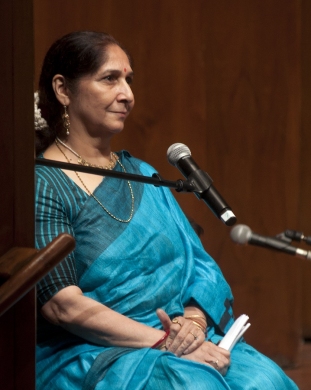 Uma Dogra 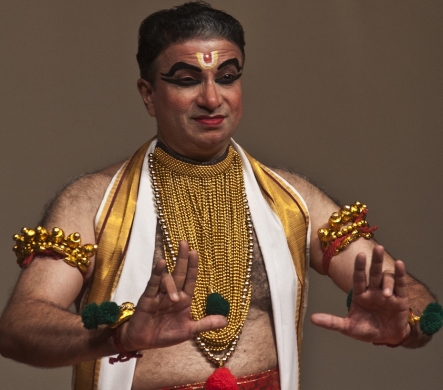 Kalamandalam Vikraman 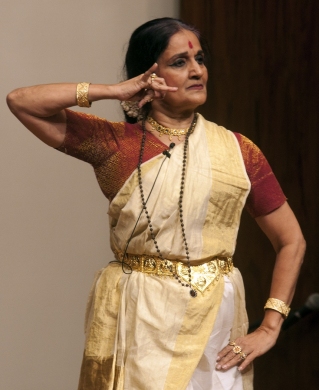 Mandakini Trivedi One full of insight was of Yoga connection and salient features like circularity, swaying, swinging, undulating, elephantine, and serpentine movements seen in Mohiniattam by Mandakini Trivedi. The rare film 'Mists of Majuli' was a complete surprise as rarely one gets a glimpse into lives of monks living in monasteries far away on an island. Sattriya dances have now gained popularity and it was thoughtful of NCPA to have a special session on Sattriya. Kathakali was also well demonstrated. The one on new directions in Odissi by Jhelum, Daksha and Debi Basu was quite an eye opener on how Guru Kelucharan Mohapatra during his workshops at NCPA encouraged the dancers to explore and perform themes that they chose. The Doordarshan film of four dancers including Anandi Ramachandran who studied Odissi was a rare one and must be preserved. One sees Guruji with these four dancers interacting and inspiring confidence. Jhelum spoke of her choreography of Bhaskaracharya's Lilavati, and other production of River Narmada and Medha Patkar's intervention, the participation of boys enacting the wall of the dam and few film songs she has experimented with to suggest nayikas, for which she confessed she had received severe criticism. But it was great to learn about how these dancers were pushing the envelope of Odissi as they say. Daksha mentioned about the themes she had taken from mythology of other countries like Australia, the story of planets and stars as in Crossing Oceans. Debi performed few stanzas of Tagore's songs using Odissi technique. Her performance reflected Kelubabu's impress vividly. She spoke of the improvisations she sometimes did while performing not knowing she was improvising, and dancing intensely. The three of them had a ball reminiscing. They recollected that for selection of dancers for the Khajuraho Dance Festival, I had been on the committee and had recommended the four of them with Guruji to participate in the festival. Kelubabu had then for the first time choreographed in Odissi, Bankim Chandra's Vande Mataram, which till today has remained memorable, as Guruji performed with the four dancers! A workshop of Western ballroom dancing, Tango and Salsa was organized with expert Sandip Sopparkar in the foyer of Tata Theatre and Folk dances by Uma Rele of Nalanda Nritya Kala Mahavidyalaya. It was an all inclusive concept. From Morn to Dusk It was 1st December which will remain etched in memories of all who performed and for those who witnessed. Swarnalata Rao, Head and Director of the Music Department of NCPA, and Swapnokalpa of Dance Dept had curated the events from morning to night under title of From Morn to Dusk featuring the greats of Indian classical dance and music. From Kolkata came the doyen of Rampur Shaswan gharana, Rashid Khan on Hindustani vocal. He was surprised to see Tata Theatre full on a Sunday morning and invested his recital with his customary command over ragas and unleashed bandishes that regaled the audience. The thundering applause he received at the end of his recital moved him so much that he confessed he had not expected so many would turn up! Then followed the charmer Zakir Hussain, son of legendary Allarakha Khan saab, who presented 'A tribute to Allarakha'. Along with violinist Kala Ramnath, Shikhar Naad Qureshi and students of Ustad Allarakha Institute of Music, he wove magic playing on tabla and showed how the young generation is making the grade in various genres of percussion playing, ensuring the legacy of Allarakha. A regular performer at NCPA, Zakir Hussain has a large following in Mumbai. The very fact that not a single seat of the spacious Tata Theatre was vacant inspired them all to give their best. The atmosphere at NCPA was charged with enthusiasm and appreciation. Four dancers, in an unusual presentation It was an unusual day. I could not believe that I would be seeing four divas of Indian dance in succession one after another in one day! From Nrityagram came under leadership of Surupa Sen, the Nrityagram ensemble with Pavitra Reddy, Dhruva, Rukmini and Abhinaya, followed by Kathak solo by Aditi Mangaldas. Soon after that, originally from Mumbai, was Malavika Sarukkai and guess who followed her - Alarmel Valli! The poet Arundhathi Subramaniam, Valli's best poet friend with whom she has collaborated, recited poems. I realized how when the theatre is full a dancer gets energized and puts her best foot forward! 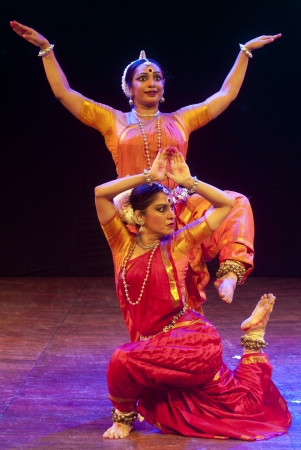 Nrityagram Having been to Nrityagram more than four times in the last three months, watching rehearsals, attending their new productions and choreographic works by Surupa Sen, I was thrilled to see some items like Sankirtan, which surprises me with its multiple nuances that Surupa has invested it with, the complete surrender to Lord Jagannath full of devotion. That for more than 25 years Surupa Sen has like a devotee spent her life there, dancing, creating choreographic works and the ensemble has won critical acclaim world over speaks volumes for their dancing. Surupa's abhinaya to ashtapadi of Gita Govinda, in which Sakhi asks Krishna to go unto the beloved who is awaiting him, was intense. Krishna's dance imbued with joyous feelings was captivating. Nrityagram has evolved their own style which stands out for its sophistication and perfection. The imaginative lighting by Lynne Fernandez colours the dancers in gentle hues creating exquisite visuals. 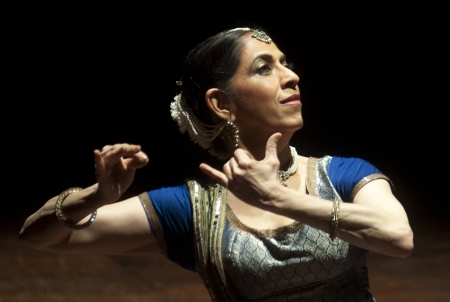 Aditi Mangaldas Aditi Mangaldas in her solo titled 'Immersed', drowned in love of Krishna, metaphorically drowned the audience in love of Krishna, described as Achyuta, Manohar, Muralidhar, Vasudev and Anant. A powerhouse of energy, she unleashed her impeccable chakkars covering the stage and pat coming on the sam that had audience eating out of her hands. Mastering her craft, using silences in contrast to storm like dance, she uses padhant, recitation, a part of Kathak sitting on the floor and speaks in soft voice all the epithets by which Krishna is known, gets up and with tintinnabulation of ankle bells surprising the audience with her command over executing tatkar that makes one wonder at the gentle sound of one ankle bell. The traditional parans, amad, pure dance numbers she weaves with mastery in her dancing, to the excellent accompaniment of percussion on tabla and padhant by Mohit Gangani and on pakhavaj by Ashish Gangani, vocal that fills up the hall by Faraz Ahmad, flute by Ravindra Rajput, and light design by Fabiana Piccoli executed by Milind Srivastav, and well designed costumes by Aditi. Looking resplendent in her blue costume, Aditi moves gracefully on the stage. In the end taking curtain calls, she started clapping with her musicians, to which the audience responded enthusiastically. She later on confessed that she was thrilled that she was sharing the same stage with her guru Birju Maharaj who was to perform later in the evening. Aditi has given traditional Kathak a new look with imagination and sophistication, giving thought on how to enhance its formal beauty. 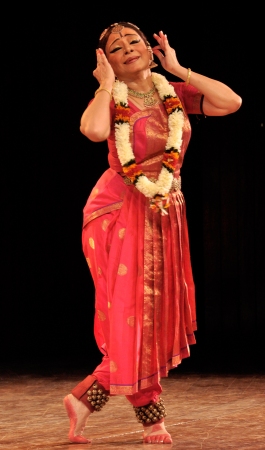 Malavika Sarukkai With bated breath one was waiting after a brief interval, to see the beauteous Malavika Sarukkai in her Bharatanatyam performance. Kala (time) was principal that marked the heartbeat of classical dance and Malavika illustrated it with excellent nritta, the concept of time that defines and measures but also on another level brings freedom and a release. Intense, extraordinary and luminous artistic mastery distinguished her performance. The choreography of Sthiti Gati to the music composed by C.V. Chandrasekhar in Madhuvanti raga expounded the concept of time. It was a sheer delight to watch her movements, the horizontal lines extending her arms slicing the space. The stances were hypnotic. The geometry of Bharatanatyam assumed another dimension in Malavika's dancing. Selecting shlokas from Srimad Bhagavata, she created visuals of miniature paintings, Krishna decorated with a garland, performing with Gopis, striking wooden sticks, clapping, multiplying himself dancing with each Gopi bringing alive the description of a shloka 'anganam anganam antare Madhavo.' Between each Gopi was Krishna dancing with joy, the joy that was transparent in Malavika's energetic Bharatanatyam, taking circles on the stage. The music for the item was composed by Sitarama Sharma in Ragamalika. Her team of musicians gave her support in a manner that lifted the performance to another level of rasanubhuti, experiencing of aesthetic pleasure. 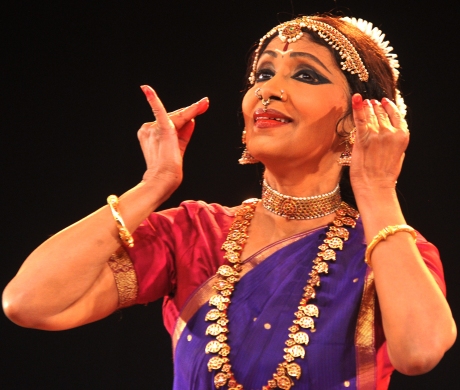 Alarmel Valli  Arundhathi Subramaniam Arundhati's recitation of Mitti (mud) was very moving. The Earth, its scent, the all pervasive feeling and yet the reality which is so stark echoed in her recitation. Valli concluded with note of hope in her dance assuring the rasikas that art can lift us from morose state. Valli's musicians included vocalist Nandini Sharma, violinist K.P. Nandini, nattuvangam by C.K. Vasudevan, mridangam by Muruganandam, flute by Sruti Sagar and lighting by Murugan. AADI ANANTA The evening with NCPA's special musical soiree Aadi Ananta saw two stalwarts in a special jugalbandhi - flute by Hariprasad Chaurasia and santoor by Shivkumar Sharma. These musicians are often resident gurus at NCPA. Forty years ago as Hariprasad reminisced, he had performed when NCPA was inaugurated. It was a special moment for him. The gentle sounds of santoor and the melodious notes on flute filled the Tata Theatre. One did not notice the time passing. Music can create that feeling of bliss.  Pt Ajay Chakravarty and Pt Birju Maharaj The bonanza was when Ajay Chakravarty and Birju Maharaj performed together. After rendering soulful thumris, Ajay Chakravarty welcomed Birju Maharaj and the audience got up as a mark of respect for Birju Maharaj. This was a touching moment. Birju Maharaj sang traditional thumris by Bindadin Maharaj. What a legacy. He said that he was not even a patch on his legendary uncle Shambhu Maharaj whose singing thumris and abhinaya were a treat. I was fortunate when I had seen in 1958 during All India Seminar on dance organized by Sangeet Natak Akademi at Vigyan Bhavan in New Delhi, Shambhu Maharaj singing and performing abhinaya to thumri Kaun gali gayo Shyam. Those halcyon days were recalled by Birju Mahraj. When he sang a thumri in which Gopi admonishes Krishna for teasing her, with one shift of a hand gesture and turning away from Krishna, Birju Maharaj made one economic gesture, depicting the annoyance of a Gopi and Krishna's dalliance! That a master, a guru so vastly gifted can cast a spell on audience was something one had not seen in recent times. The melodious singing by Birju Maharaj and economical gestures epitomizing womanly gestures was something that awed one and all. At one point Birju Maharaj asked Ajay Chakravarty to sing a stanza with tala and to each beat of the tala, Birju Maharaj spontaneously enacted abhinaya. This working together by two maestros was an amazing combination, the like of which one does not know when it could be repeated. Doubtless it was the high point of the Morn to Dusk program. More was to follow at the Jamshed Bhabha Theatre with Roysten Abel's The Magnificent Manganiyar Seduction, but I had already seen it at Kennedy Centre in 2011 during Maximum India. The bliss When I returned to my hotel facing the Arabian Sea and with lighting that has been described as Queen's Necklace, my cup of joy was overflowing. The close association with NCPA for more than thirty years was so precious that it had offered me an opportunity to be with these artistes once again and shall remain a precious memory for lifetime. Thank you, NCPA, an institution that has nurtured our classical arts in a big way for half a century and shall continue to nurture in future.  Dr. Sunil Kothari is a dance historian, scholar, author and critic, Padma Shri awardee and fellow, Sangeet Natak Akademi. Dance Critics' Association, New York, has honoured him with Lifetime Achievement award. Post your comments Please provide your name and email id when you use the Anonymous profile in the blog to post a comment. All appropriate comments posted with name and email id in the blog will also be featured in the site. |